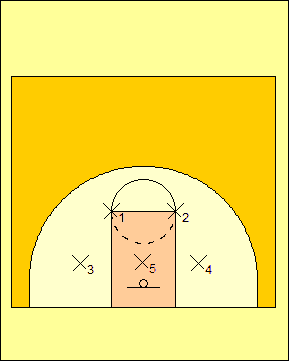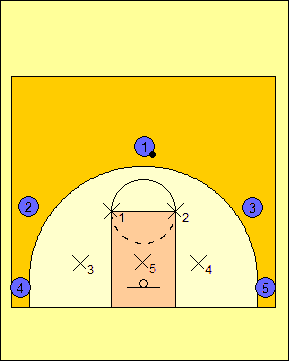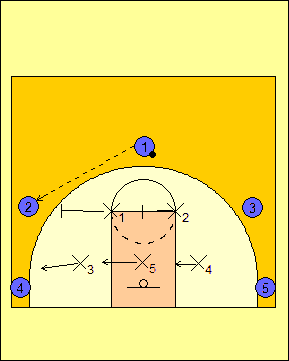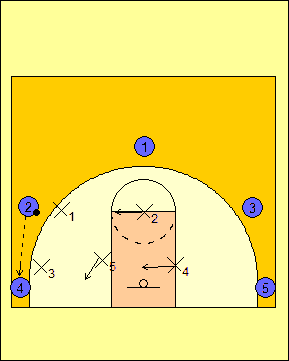
Basketball Coaching DVD's at Championship Productions
2-3 (2-1-2) ZONE DEFENSE
With the recent success of teams like Syracuse and Baylor in their use of the
2-3 zone defense, coaches and teams are interested in finding out more about
this scheme that has produced national champions and stifled offenses at various
levels of the game. Here is a look at this defense that has caused many an
offensive coach, such as myself, many sleepless nights.
Advantages of the 2-3 (2-1-2) Zone Defense
The zone has several advantages that should be taken into consideration when a
coach wishes to utilize the 2-3 zone. They include, but are not limited
to:
-
The defense allows you to protect your center.
Because the two guards and the two forwards are responsible for
covering the perimeter, the center is essentially protected on the
inside. He will be allowed to cover the low post area and can
cause problems for penetration into the post area whether it is on
the dribble or by the use of the pass.
-
Versatility the defense. This defense
has the ability to be used as a straight zone, a point zone or as a
match-up zone as illustrated in my piece on match-up zone defenses.
With the 2-3 zone defense, there are several applications that can
be used to give your team a multiple defense.
-
Ability to dictate where your players will
defend. If you have defensive players you do not want
guarding near your basket, the 1-2-2 zone allows you to hide them
from playing post defense. All you have to do is put your
players where you feel they are best suited to play defense instead
of having to determine a defensive match-up for each player.
-
The zone is an attractive defense to start the
fast break. Because of the alignment of a point and two
wings at the top of the zone, the formation of the defense is a
great way to get players into their lanes and attack the basket with
a three-man fast break and both posts trailing.
Disadvantages of the 2-3 (2-1-2) Zone Defense
However, there are also some disadvantages that need to be considered before
deciding to use the 2-3 zone defense. They include, but are not limited
to:
-
Inability to cover the point and the wings.
Because of the positioning of the guards, forwards and center in the
zone, the areas at the top of the three-point arc and the area just
below the free-throw line extended are vulnerable. We also
have some vulnerability in the short corners if we go to a 2-3 look.
However, we can cover the low blocks with a 2-1-2 look in lieu of a
2-3 look.
-
Like all zones, the offense can dictate the
match-ups. The offense can create mismatches by putting
relatively weak defensive players against relatively strong
offensive players. Also, the offense can dictate where
particular personnel can be set up against the defense. When
this happens, the zone really cannot adjust and the defense is
caught in a bind.
-
Like all zones, your players must either be quick
or long with a preference for both. Slow and short teams
typically do not play great zone defense because they are not able
to cover ground quickly. Zones are advantageous for long and
quick teams because they can shrink the size of the gaps in the zone
better than shorter and slower players. Because of this, teams
with length and quickness prosper more in running a zone defense
than those that are not.
-
Zone defenses are relatively passive in nature.
Because the zone is designed to be packed inside the three-point
arc, the defense is not looking to actively steal perimeter passes.
While some passes might be intercepted, the zone is not a great way
to force turnovers. Instead, the zone is designed to control
the action from inside the three-point line and force several long
shots.
Setting Up the Defense
The first two players placed in the zone are X1 and X2, the guards. X1 and
X2 will cover the area inside the top half of the three-point arc and will guard
the basketball when it is at the top of the zone.
The back row of the 2-3 zone are X3, X4 and X5. X3 and X4 are the forwards
while X5 is the center. X3 and X4 will have the responsibility of covering
the corner when the ball is on their side and the area from the basket to the
low post on their side when they are help side. X5 will be required to
dead front any ball-side post player when the ball is below the free-throw line
extended.
Diagram 1 shows the defense as diagrammed and Diagram 2 shows the defense when
the ball is brought across half court. We will not go into the defensive
adjustments until the ball is entered to or below the wing area.

Diagram 1 |

Diagram 2 |
Slides of the 2-3 (2-1-2) Zone
We start the defense with our normal alignment as was
illustrated in Diagrams 1 and 2. If the ball is passed from the
point to the wing, we want X1 to cover the receiver if this is the first
pass. We will shift the rest of the players in the zone
accordingly (Diagram 3). If the ball is passed from the point to
the wing and this was not the first pass, we will have the forward cover
the receiver of the pass until a guard is able to replace him with what
we call a bump.
Diagram 4 illustrates what we want when the ball is
passed from the wing to the corner. The real movement is not with
X1 and X3 as is shown in the illustration, but with the backside three
players. We will have the backside guard cover the ball side high
post, the center fronting in the low post and the backside forward
covering the basket area.

Diagram 3 |

Diagram 4 |
Read the full article and many others by signing up for a Coach Peel
Basketball membership today.
Membership Subscription with Monthly Payments: $6.00 per
month
Membership Subscription with Quarterly Payments:
$15.00 per quarter (save over 16.6%)
Membership Subscription with Annual Payments: $50.00 per
year (save over 30.5% & get your first 30 days free!)

© 2010-2017 Alan Peel Enterprises